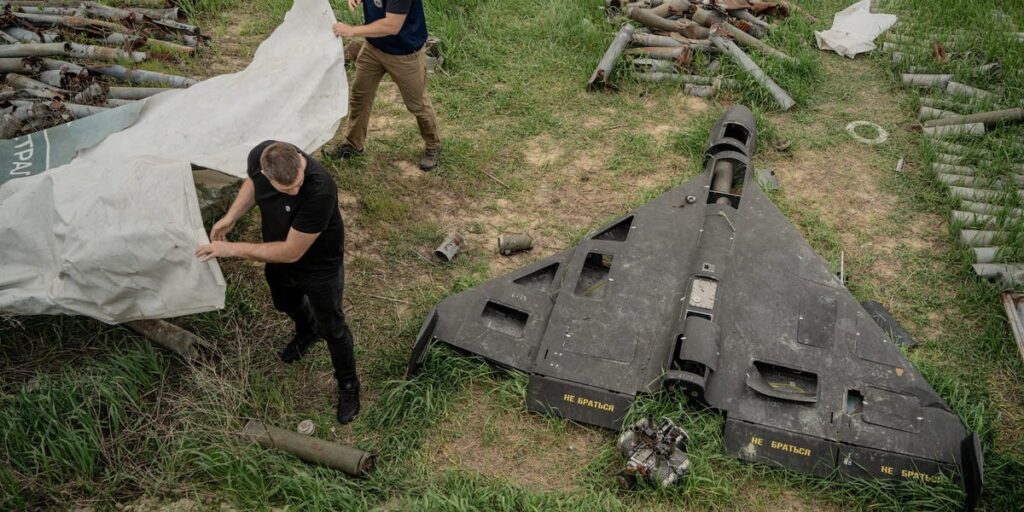A massive Russian strike on Ukraine relied on Western technology, President Volodymyr Zelenskyy said, claiming that more than 100,000 foreign-made components were found in the drones and missiles used in the overnight attack.
He said that Russia fired 496 strike drones and 53 missiles at Ukraine on Sunday night, and there were 102,785 foreign components in them that came from companies in the US, the UK, China, Taiwan, Germany, Switzerland, Japan, Korea, and the Netherlands.
He said there were around 100,688 foreign-made parts in the drones, which included around 250 powerful Shahed-style drones, and around 1,500 foreign-made parts in Russia’s Iskander missiles, 192 in its Kinzhal missiles, and 405 in its Kalibr missiles.
It’s the latest in a string of examples of what Ukraine says are foreign-made parts, including Western ones, in Russian weaponry, despite many of those countries putting heavy sanctions on Russia, including ones that try to stop Russia from getting any technology it could use in weaponry.
“Every Russian missile and every Russian attack drone also contain parts that are still being supplied to Russia from Western countries and various countries close to Russia,” Zelenskyy said in his Monday address.
He did not name any specific companies, but said what sort of components Ukraine had identified from each country.
He said that US companies manufacture multiple products used in some Russian weaponry, including converters used in Russia’s Kh-101 missiles and its Shahed-type drones, sensors used by those drones and Kinzhal missiles, analog-to-digital converters used in drones and missiles, and microelectronics used in rockets.
He also pointed to UK-made microcomputers used for Russian drone flight control, microcontrollers for Russian drones made in Switzerland, and switching connectors produced in Germany, among other examples. He said the largest volume of diverse microelectronics was from China and Taiwan.
He said that the data on the companies and components is given to Ukraine’s partners.
Some of the countries identified, like the UK and the Netherlands, are among Ukraine’s biggest supporters, providing it with military aid and training its soldiers to fight back against Russia.
Companies can’t fully control where their goods end up. Sanctions have sharply limited Russia’s access to advanced Western technology, but enforcement gaps remain. Dual-use items and civilian supply chains allow Moscow to keep sourcing electronics through other countries, and these gaps are hard to close.
But Zelenskyy on Monday expressed frustration that Russia was still able to get some foreign components. “Now, in the fourth year of the full-scale war, it is simply strange to hear anyone claim they don’t know how to stop the flow of critical components.” He said it must be stopped.
It’s a constant race, and Western companies frequently tighten their rules to try to stop Russia from getting components for weapons. Ukraine has publicly thanked partners for their sanctions, but it has also proposed ways that partner nations can further restrict Russia’s access, such as shipping restrictions.
Zelenskyy said that a meeting of G7 sanctions coordinators is scheduled for this week, though this is not something the G7 has announced publicly.
Vladyslav Vlasiuk, a sanctions expert who works for Ukraine’s government on its sanctions policy, said on Monday that “a systemic, coordinated G7-level decision is needed to close these loopholes and ensure sanctions are effective.”
Ukraine has repeatedly flagged the presence of foreign-made parts in Russian weaponry, including in the Geran-3, a new Russian jet-powered attack drone. Ukraine’s military intelligence agency said last month that it has nearly 50 foreign components inside.
Ukraine also said earlier this year that Russia’s new drone-launched cruise missile had parts from partners, including the US, and that it found a Russian tank and armored vehicle maker was using 260 units of foreign-made equipment.
Russia’s drone and missile bombardments are a massive problem for Ukraine. They strike cities across Ukraine, including those far from the front-line fighting. The relentless attacks have killed civilians and damaged or destroyed infrastructure.
Read the full article here


